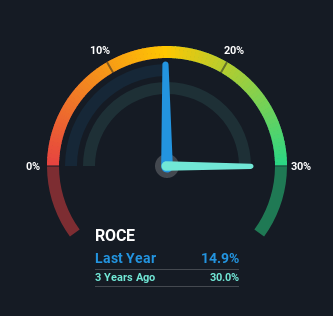Capital Allocation Trends At IAA (NYSE:IAA) Aren't Ideal
If you're looking for a multi-bagger, there's a few things to keep an eye out for. One common approach is to try and find a company with returns on capital employed (ROCE) that are increasing, in conjunction with a growing amount of capital employed. If you see this, it typically means it's a company with a great business model and plenty of profitable reinvestment opportunities. Although, when we looked at IAA (NYSE:IAA), it didn't seem to tick all of these boxes.
Return On Capital Employed (ROCE): What is it?
Just to clarify if you're unsure, ROCE is a metric for evaluating how much pre-tax income (in percentage terms) a company earns on the capital invested in its business. The formula for this calculation on IAA is:
Return on Capital Employed = Earnings Before Interest and Tax (EBIT) ÷ (Total Assets - Current Liabilities)
0.15 = US$346m ÷ (US$2.6b - US$294m) (Based on the trailing twelve months to March 2021).
Thus, IAA has an ROCE of 15%. On its own, that's a standard return, however it's much better than the 7.5% generated by the Commercial Services industry.
View our latest analysis for IAA
In the above chart we have measured IAA's prior ROCE against its prior performance, but the future is arguably more important. If you're interested, you can view the analysts predictions in our free report on analyst forecasts for the company.
What Can We Tell From IAA's ROCE Trend?
In terms of IAA's historical ROCE movements, the trend isn't fantastic. Over the last four years, returns on capital have decreased to 15% from 26% four years ago. However it looks like IAA might be reinvesting for long term growth because while capital employed has increased, the company's sales haven't changed much in the last 12 months. It's worth keeping an eye on the company's earnings from here on to see if these investments do end up contributing to the bottom line.
On a related note, IAA has decreased its current liabilities to 11% of total assets. So we could link some of this to the decrease in ROCE. Effectively this means their suppliers or short-term creditors are funding less of the business, which reduces some elements of risk. Some would claim this reduces the business' efficiency at generating ROCE since it is now funding more of the operations with its own money.
The Key Takeaway
Bringing it all together, while we're somewhat encouraged by IAA's reinvestment in its own business, we're aware that returns are shrinking. Since the stock has gained an impressive 64% over the last year, investors must think there's better things to come. However, unless these underlying trends turn more positive, we wouldn't get our hopes up too high.
Like most companies, IAA does come with some risks, and we've found 1 warning sign that you should be aware of.
If you want to search for solid companies with great earnings, check out this free list of companies with good balance sheets and impressive returns on equity.
This article by Simply Wall St is general in nature. It does not constitute a recommendation to buy or sell any stock, and does not take account of your objectives, or your financial situation. We aim to bring you long-term focused analysis driven by fundamental data. Note that our analysis may not factor in the latest price-sensitive company announcements or qualitative material. Simply Wall St has no position in any stocks mentioned.
Have feedback on this article? Concerned about the content? Get in touch with us directly. Alternatively, email editorial-team (at) simplywallst.com.

